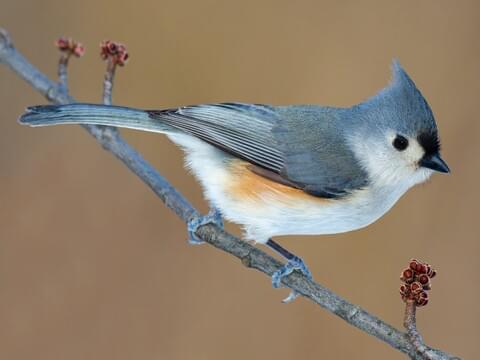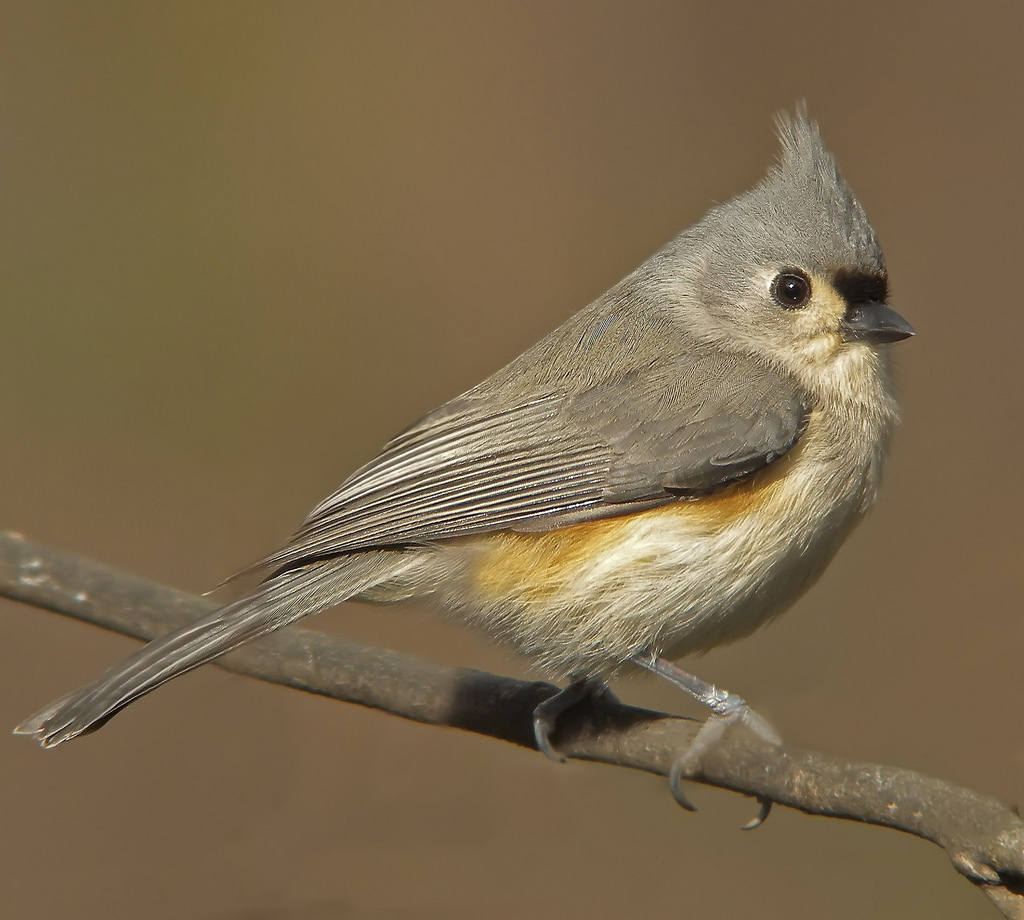The Tufted Titmouse, a small and adorable bird found in the eastern United States, is a frequent visitor to bird feeders. These social birds are not afraid of people and are known for their distinctive songs and calls. While they are especially attracted to feeders during the winter months, they switch to eating insects in the summer. With their numbers steadily increasing and their range expanding, it’s no wonder these lovely birds have captured the hearts of bird enthusiasts. They enjoy a variety of foods, including sunflower seeds, peanuts, acorns, and beech nuts, making them easy to please when it comes to feeder selection. For those interested in attracting these charming creatures to their yards, an ideal feeder placement would be about 5 feet high and placed approximately 15 feet away from the house, with a small tree nearby. Additionally, having deciduous trees and water sources in the yard can further entice the Tufted Titmice to visit. However, if their numbers become overwhelming, temporarily pausing bird feeding altogether may be necessary.

Description of Tufted Titmice
The Tufted Titmice are charming little birds that can be commonly found in the eastern United States. They are known for their friendly and social nature, often approaching bird feeders without fear. In this article, we will delve into their appearance, behavior, range, population, feeding habits, identification, increasing numbers and range, feeder preferences, habitat requirements, and how to deal with overpopulation.
Appearance
The Tufted Titmice are small in size, measuring approximately 5-6 inches in length. They have a distinct appearance with a grey body, a cream-colored belly, and a prominent pointed crest on their head. Their eyes are black and surrounded by white feathers, which adds to their adorable charm. Furthermore, their wings and tail feathers are a darker charcoal gray, providing a beautiful contrast to their lighter body.
Behavior
These delightful birds are not only visually appealing but also display fascinating behaviors. Tufted Titmice are highly social creatures, often seen foraging in small flocks or pairs. They are known to communicate with each other using a variety of songs and calls, enabling them to maintain strong social bonds. In addition, these birds are incredibly agile and can often be observed swiftly maneuvering through trees and branches in search of food.
Range and Population
Originally found primarily in the eastern United States, the range of Tufted Titmice has been steadily expanding over the years. They can now be spotted as far west as Texas and as far north as southern Ontario, Canada. This range expansion indicates a healthy and increasing population, which is undoubtedly a positive sign for bird enthusiasts and conservationists alike.
Feeding Habits
When it comes to feeding, Tufted Titmice exhibit interesting dietary preferences that vary based on the season. Let’s explore their winter and summer diets, as well as their favorite foods and attraction to suet.
Winter Diet
During the winter months, when natural food sources are scarce, Tufted Titmice rely heavily on bird feeders for sustenance. They display a particular affinity for sunflower seeds, which are a readily available and energy-rich food source for them. Additionally, they also consume peanuts, acorns, and beech nuts, making the most of the available resources in their environment.
Summer Diet
In the summer, Tufted Titmice switch gears and rely more on insects as a primary food source. They actively hunt insects, such as beetles and caterpillars, to supplement their diet. This dietary shift aligns with the abundance of insects during the warmer months, allowing the birds to take advantage of the readily available protein.
Favorite Foods
Although the Tufted Titmice exhibit a diverse diet, they do have some favorite foods. Sunflower seeds, with their high fat and protein content, are among their top choices. They also have a preference for peanuts, thanks to their energy-rich properties. Additionally, acorns and beech nuts are highly sought-after by these delightful birds.
Attracted to Suet
Suet is a type of food that Tufted Titmice find particularly appealing, especially during the winter months. Suet is made from animal fat and provides a concentrated source of energy, making it an ideal winter food for birds. Its high fat content helps the birds maintain their body temperature during cold weather, providing them with the necessary fuel to survive frosty days.
Identifying Tufted Titmice
Spotting a Tufted Titmouse can be a delightful experience, made easier if one knows what to look for in terms of songs, calls, and physical features. Let’s explore how to identify these charming birds.
Songs and Calls
Tufted Titmice are known for their distinct repertoire of songs and calls. Their songs often consist of simple, clear whistled phrases that may be repeated several times. These musical calls are a defining feature of the species and can help birdwatchers identify their presence. Additionally, they emit a variety of vocalizations such as “fee-bee” or “peter, peter, peter,” which only add to their charismatic nature.
Physical Features
In terms of physical features, there are several key characteristics one can look for to identify Tufted Titmice. Their small size, approximately 5-6 inches in length, is a good starting point. The combination of gray feathers on their body, cream-colored bellies, and contrasting dark gray wings and tail feathers create a striking appearance. The most distinguishing feature, however, is their prominent pointed crest on the top of their head. These unique features make them easily recognizable and a joy to observe.
Increasing Numbers and Range
Over the years, the population of Tufted Titmice has been on the rise, along with an expansion of their range. Let’s explore the factors contributing to their increasing numbers and expanding habitat.
Population Growth
The increased population of Tufted Titmice can be attributed to several favorable factors. Their adaptability to various habitats, from forests to residential areas, has allowed them to thrive. Additionally, their ability to consume a wide range of foods, both natural and provided by bird feeders, ensures their nutritional needs are met. Furthermore, the conservation efforts aimed at preserving and restoring their preferred habitats have played a significant role in their population growth.
Expanding Habitat
Originally found predominantly in the eastern United States, Tufted Titmice have successfully expanded their range over time. They can now be observed in regions as far west as Texas and as far north as southern Ontario, Canada. This expansion demonstrates their adaptability and resilience, as they have been able to establish populations in areas with diverse climates and ecosystems. The increasing availability of suitable habitats, including both forested areas and residential landscapes, has contributed to their successful range expansion.

Feeder Preferences
When it comes to attracting Tufted Titmice to your backyard, they are not particularly picky about the type of feeder you provide. However, feeder placement plays an important role in their attraction and feeding habits. Let’s explore the preferred feeder types and ideal feeder placement for these charming birds.
Feeder Type
Tufted Titmice are not picky when it comes to feeder types. They will readily frequent tube feeders, hopper feeders, and platform feeders. The key is to ensure that the feeder is well-stocked with their favored food sources, such as sunflower seeds and peanuts. Providing a variety of feeder types and placing them at different heights can further enhance the appeal for these delightful birds.
Ideal Feeder Placement
To maximize the chances of attracting Tufted Titmice, it is important to consider the ideal feeder placement. Aim to place the feeder at a height of approximately 5 feet, allowing the birds easy access while keeping them safe from potential predators. Additionally, positioning the feeder around 15 feet away from your house, with a small tree nearby, provides the birds with a sense of security and shelter. Placing the feeder in close proximity to suitable perching spots, such as shrubs or trees, further encourages the birds to visit and spend time in your yard.
Habitat Requirements
Creating an inviting environment for Tufted Titmice involves catering to their habitat preferences. Let’s explore the features that make a yard appealing to these charming birds.
Preferred Yard Features
Tufted Titmice are particularly drawn to yards with deciduous trees, as they provide an abundance of food resources and shelter. The presence of water sources, such as birdbaths or small ponds, is also highly attractive to these birds, as it satisfies their need for hydration and bathing. Additionally, incorporating native plants in your yard can further enhance its appeal, as they attract insects that serve as a valuable food source for these delightful birds. Creating a diverse and well-maintained landscape with a combination of suitable trees, water sources, and native plants is the key to attracting and retaining Tufted Titmice in your yard.

Dealing with Overpopulation
If you find yourself with an overpopulation of Tufted Titmice in your yard, it may be necessary to implement measures to control their numbers. A temporary cessation of bird feeding can help mitigate the issue.
Temporary Cessation of Bird Feeding
Halting bird feeding for a period of time can indirectly address the issue of overpopulation. By removing the artificial food source, the Tufted Titmice are encouraged to disperse and seek natural food sources in the surrounding environment. This allows the bird population to naturally balance itself and prevents an unsustainable concentration of birds in a limited area. Once the population has stabilized, bird feeding can be resumed, ensuring a healthy and diverse avian community.
In conclusion, Tufted Titmice are friendly and sociable birds that captivate bird enthusiasts with their charming appearance, behavior, and songs. Understanding their feeding habits, identification features, habitat preferences, and measures for managing their population allows us to appreciate and support the successful growth of these delightful birds. By providing them with suitable feeders, a well-designed habitat, and occasional management strategies, we can continue to enjoy the presence of Tufted Titmice in our surroundings while promoting their long-term well-being.
Leave a Reply